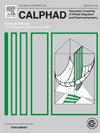Experimental determination and thermodynamic assessment of the phase equilibrium states of an Al–Cr–Ce ternary system
IF 1.9
3区 材料科学
Q4 CHEMISTRY, PHYSICAL
Calphad-computer Coupling of Phase Diagrams and Thermochemistry
Pub Date : 2025-10-07
DOI:10.1016/j.calphad.2025.102886
引用次数: 0
Abstract
The phase equilibrium states of an Al−Cr−Ce ternary system were systematically investigated through experimental analysis and thermodynamic modeling. The 800 and 1000 °C isothermal sections of the Al−Cr−Ce ternary system were constructed using the equilibrium alloy method based on the results of scanning electron microscopy, energy-dispersive spectroscopy, and X-ray diffraction analyses. Fourteen three-phase equilibrium regions were confirmed and two three-phase equilibrium regions were speculated at 800 °C, whereas 10 three-phase equilibrium regions were determined and one three-phase equilibrium region was speculated at 1000 °C. Two new ternary compounds—τ3 and τ4—were discovered, and it was found that the τ3 phase was stable at both 800 and 1000 °C; however, the τ4 phase was only stable at 800 °C, and it disappeared at 1000 °C. In addition, four types of primary solidification regions—τ1, Al4Ce, Al2Ce, and (Cr)—were detected. Based on the experimental results obtained in this study and the data available from previous literature, the thermodynamic modeling of the Al−Cr−Ce ternary system was performed using the CALPHAD method, and a set of self-consistent thermodynamic parameters between the experimental and calculated results was satisfactorily obtained for the Al−Cr−Ce ternary system.
Al-Cr-Ce三元体系相平衡态的实验测定和热力学评价
通过实验分析和热力学模拟,系统地研究了Al - Cr - Ce三元体系的相平衡态。基于扫描电镜、能量色散光谱和x射线衍射分析结果,采用平衡合金法构建了Al - Cr - Ce三元体系800和1000℃等温切片。在800℃下确定了14个三相平衡区,推测出2个三相平衡区;在1000℃下确定了10个三相平衡区,推测出1个三相平衡区。发现了两个新的三元化合物τ3和τ4,发现τ3相在800℃和1000℃时都是稳定的;而τ4相仅在800℃时稳定,在1000℃时消失。此外,还发现了τ1、Al4Ce、Al2Ce和(Cr)四种类型的初次凝固区域。在实验结果和文献资料的基础上,利用CALPHAD方法对Al - Cr - Ce三元体系进行了热力学建模,得到了Al - Cr - Ce三元体系的一组实验结果与计算结果自洽的热力学参数。
本文章由计算机程序翻译,如有差异,请以英文原文为准。
求助全文
约1分钟内获得全文
求助全文
来源期刊
CiteScore
4.00
自引率
16.70%
发文量
94
审稿时长
2.5 months
期刊介绍:
The design of industrial processes requires reliable thermodynamic data. CALPHAD (Computer Coupling of Phase Diagrams and Thermochemistry) aims to promote computational thermodynamics through development of models to represent thermodynamic properties for various phases which permit prediction of properties of multicomponent systems from those of binary and ternary subsystems, critical assessment of data and their incorporation into self-consistent databases, development of software to optimize and derive thermodynamic parameters and the development and use of databanks for calculations to improve understanding of various industrial and technological processes. This work is disseminated through the CALPHAD journal and its annual conference.

 求助内容:
求助内容: 应助结果提醒方式:
应助结果提醒方式:


